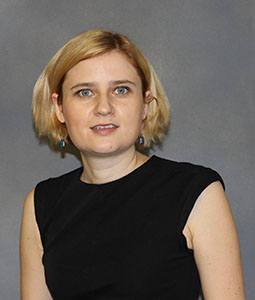Department of Chemistry and Biochemistry
Faculty and Staff Directory
Natalia B. Shustova
| Title: | Peter and Bonnie McCausland Fellow / Hans Fischer Fellow / Professor Catalysis / Crystallography / Inorganic / Organic / Materials / Physical and Theoretical / Solid State / Supramolecular |
| McCausland College of Arts and Sciences | |
| Email: | shustova@mailbox.sc.edu |
| Phone: | 803-777-1903 |
| Fax: | 803-777-9521 |
| Office: | Office: GSRC 533 Lab: GSRC 405, 803-777-9852 Lab 2: GSRC 511, 803-777-4241 |
| Resources: |
CV [pdf] |

Education
B.S., 2002, Moscow State University
M.S., 2004, Moscow State University
Ph.D., 2005, Physical Chemistry, Moscow State University
Ph.D., 2010, Inorganic Chemistry, Colorado State University
Honors and Awards
Russell Research Award 2024
Friedrich Wilhelm Bessel Research Award
The Alexander von Humboldt Foundation 2024
Camille Dreyfus Teaching-Scholar Award 2019
McCausland Fellowship 2019
Distinguished Undergraduate Research Mentor Award 2019
Breakthrough Award 2017
Alfred P. Sloan Research Award 2017
Cottrell Scholar Award 2017
Scialog Fellow, Research Corporation for Science Advancement 2017
National Science Foundation Career Award 2016
IAS Hans Fischer Fellowship 2020
Research Interests
Research in my group will focus on materials for sustainable energy conversion, sensing, switches, and artificial biomimetic systems. Development of these materials will involve the synthesis and characterization of the porous (e.g., metal-organic frameworks (MOFs) and covalent-organic frameworks (COFs)) and graphitic materials. Specifically, three main directions related to 1) morphology control of the active layer of a bulk heterojunction solar cell, 2) light harvesting and energy transfer in well-defined self-assemblies, and 3) design of artificial scaffolds mimicking protein behavior will be developed.
Students who are interested in inorganic chemistry, materials, or physical chemistry are strongly encouraged to join. Each student in my group will be trained in synthesis and techniques for manipulating air-sensitive compounds, powder diffraction analysis, single-crystal X-ray crystallography, thermogravimetric analysis, and spectroscopy (UV-vis, IR, Fluorescence).
The Active Layer Morphology Control in Organic Photovoltaics. Increase of efficiency in the currently used bulk heterojunction solar cells, the realistic candidates for an efficient photoenergy conversion, can be achieved through the precise control of the active layer morphology at the nanoscale level. The ultimate goal of the research in my group is to design new materials that can be used as active layer components, which will lead to efficiency enhancement of solar cells.
Light Harvesting and Controllable Energy Transfer in Well-Defined Self-Assemblies. Light harvesting chromophore assemblies with an ability to control Förster resonance energy transfer (FRET) processes are required for the preparation of the next generation organic photovoltaics, molecular-scale digital switches, and sensors coupled to FRET. To address these issues, a new strategy to control energy transfer processes in self-assembled well-defined arrays of chromophores with integrated photochromic linkers will be developed.
Selected Publications
Lim, J.; Park, K. C.; Thaggard, G. C.; Liu, Y.; Maldeni Kankanamalage, B. K. P.; Toler, D. J.; Ta, A. T.; Kittikhunnatham, P.; Smith, M. D.; Phillpot, S. R.; Shustova, N. B. J. Am. Chem. Soc. 2024, 146, 17, 12155
Thaggard, G. C.; Park, K. C.; Lim, J.; Maldeni Kankanamalage, B. K. P.; Haimerl, J.; Wilson, G. R.; McBride, M. K.; Forrester, K. L.; Adelson, E. R.; Arnold, V. S.; Wetthasinghe, S. T.; Rassolov, V. A.; Smith, M. D.; Sosnin, D.; Aprahamian, I.; Karmakar, M.; Bag, S. K.; Thakur, A.; Zhang, M.; Tang, B. Z.; Castaño, J. A.; Chaur, M. N.; Lerch, M. M.; Fischer, R. A.; Aizenberg, J.; Herges, R.; Lehn, J.-M.; Shustova, N. B. Nat. Commun. 2023, 14, 7556.
Thaggard, G. C.; Haimerl, J.; Park, K. C.; Lim, J.; Fischer, R.; Maldeni Kankanamalage, B. K. P.; Yarbrough, B. J.; Wilson, G. R.; Shustova, N. B.* “Metal-Photoswitch Friendship: From Photochromic Complexes to Functional Materials” J. Am. Chem. Soc. 2022, 51, 23249–23263.
Park, K. C.; Kittikhunnatham, P.; Lim, J.; Thaggard, G. C.; Liu, Y.; Martin, C. R.; Leith, G. A.; Toler, D. J.; Ta, A. T.; Birkner, N.; Lehman-Andino, I.; Hernandez-Jimenez, A.; Morrison, G.; Amoroso, J. W.; zur Loye, H.-C.; DiPrete, D. P.; Smith, M. D.; Brinkman, K. S.; Phillpot, S. R.; Shustova, N. B.* “f-block MOFs: A Pathway to Heterometallic Transuranics” Angew. Chem. Int. Ed. 2023, 62, DOI: https://doi.org/10.1002/anie.202216349.
Park, K. C.; Martin, C. R.; Leith, G. A.; Thaggard, G. C.; Wilson, G. R.; Yarbrough, B. J.; MaldeIni Kankanamalage, B. K. P.; Kittikhunnatham, P.; Mathur, A.; Jatoi, I.; Manzi, M. A.; Lim, J.; Lehman-Andino, I.; Hernandez-Jimenez, A.; Amoroso, J. W.; DiPrete, D. P.; Liu, Y.; Schaeperkoetter, J.; Misture, S. T.; Phillpot, S. R.; Hu, S.; Li, Y.; Leydier, A.; Proust, V.; Grandjean, A.; Smith, M. D.; Shustova, N. B.* “Capture Instead of Release: Defect-Modulated Radionuclide Leaching Kinetics in Metal-Organic Frameworks” J. Am. Chem. Soc. 2022, 144, 16139–16149.
Thaggard, G. C.; Leith, G. A.; Sosnin, D.; Martin, C. R.; Park, K. C.; McBride, M. K.; Lim, J.; Yarbrough, B. J.; Maldeni Kankanamalage, B. K. P.; Wilson, G. R.; Hill, A. R.; Smith, M. D.; Garashchuk, S.; Greytak, A. B.; Aprahamian, I.; Shustova, N. B.* “Confinement-Driven Photophysics in Hydrazone-based Hierarchical Materials” Angew. Chem. Int. Ed., 2023, DOI: 10.1002/anie.202211776 (VIP paper).